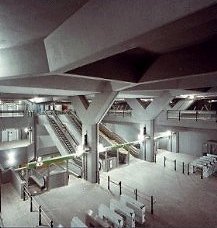 Underground tracks
Underground tracksWhen traveling by train through London or Paris, you may run into trouble switching from one station to another. You must get off your train, take your luggage with you, search for a subway or a taxi, get on it, and at long last settle down in another train. This is because when the big train stations of Europe were built, during the 19th century, every track coming from North, South, East or West stopped outside the city centre.
"Railway Junction"
That was the state of the art, and Milan is no exception. Since the 1960s, however, the City Council has being digging tunnels under the city, so trains coming - say - from Paris (i.e. from the North) can comfortably go straight under the city centre on their way to - say - Venice (East of Milan).
.:. It sounds good, doesn't it? The only problem with this so-called Passante ferroviario (or "Railway Junction") system has been the longwindedness of each and every Italian authority involved.
.:. The Passante has taken some thirty years to begin its operations, and only since December 1997 a first track of it has become available to the travellers. An extension to the an already existing railway station, Milano Certosa, began to operate in 1999. A really new urban station, Dateo, has opened in June 2002. Another, Porta Vittoria, in December 2004. More have followed.
What you can use
Every day, from early morning till 'round midnight, you can ride trains running from Bruzzano, the Bovisa railway station (in the northern section of Milan), Dateo (not far from the city centre), the old Fiera, to Rogoredo (on the railway line towards Bologna and Rome), and vice versa.
.:. These trains are frequent, and take less than forty minutes to cover the distance. You can ride them free if you don't get out of Milan and have already checked into the city's subway system or the TreNord train network (which links the town to many places in the surrounding area).
Another subway line, in fact
The very first stations to become operational along the Passante - like Porta Venezia or Repubblica - are quite big, as they were designed for international traffic. In fact, however, the Passante simply provides the Milan subway network with another line.

The Porta Venezia Passante station

The gallery of the Porta Venezia Passante station
.:. CiaoMilano was conceived and is edited by KIWI Milano. It relies on the Foundation 6 framework, and is released under a Creative Commons Attribution-NonCommercial-NoDerivs 4.0 International licence.
.:. Icons by
.:. copyright © 1997-2025 Roberto Peretta, Milano; copyright © 1997-2006 Monica Levy, Milano
.:.Monica Levy, who created this website in 1997, is no longer with us. Her smile is behind this word.
Da Vinci = No Problem

The Last Supper, otherwise difficult to book?
You can reserve a specialized visit through our partner Musement.

The Last Supper, otherwise difficult to book?
You can reserve a specialized visit through our partner Musement.
CiaoMilano does not collect personal data or e-mail addresses, except for press professionals and readers who write directly.
Our Privacy Policy
updated on December 24, 2025
Our Privacy Policy
updated on December 24, 2025
 Milano
Milano Hotels
Hotels What's On
What's On Eating
Eating Shops
Shops After dark
After dark Out of town
Out of town





